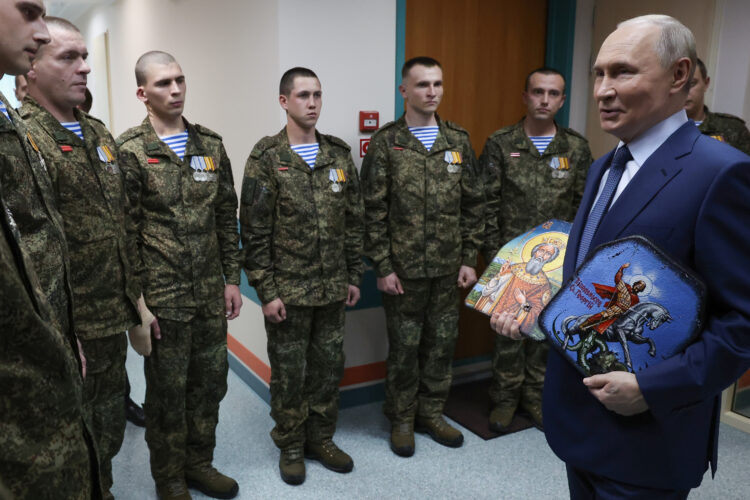Putin says Russia’s nuclear-armed underwater drone was tested successfully

President Vladimir Putin holds Russian Orthodox icons as he meets with soldiers wounded in action in Ukraine, at the the Mandryk Central Military Clinical Hospital, in Moscow, Russia, Wednesday, Oct. 29, 2025. (Vyacheslav Prokofyev, Sputnik, Kremlin Pool Photo via AP)
MOSCOW (AP) — Russia has conducted a successful test of a new atomic-powered and nuclear-capable underwater drone, President Vladimir Putin said Wednesday, declaring that the new weapon can’t be intercepted.
Putin’s statement, which comes three days after he praised a successful test of a new nuclear-powered cruise missile, appears to be another message to U.S. President Donald Trump that Russia is standing firm in its maximalist demands on Ukraine.
Speaking at a meeting with soldiers wounded in Ukraine, Putin said the Poseidon drone was tested while running on nuclear power for the first time Tuesday, describing it as unmatched in speed and depth.
He said the nuclear reactor that powers Poseidon is “100 times smaller” than those on submarines, and the power of its nuclear warhead is “significantly higher than that of our most advanced Sarmat intercontinental ballistic missile.”
Putin first mentioned the underwater nuclear-powered drone in his 2018 state-of-the-nation address along with other prospective weapons. Russian media reported that Poseidon was designed to explode near coastlines and unleash a powerful radioactive tsunami.
Putin said that during Tuesday’s test, Poseidon traveled on nuclear power for the first time. He didn’t say where the trials were conducted or give any other details.
“For the first time, we managed not only to launch it from its carrier submarine … but also to activate its nuclear power unit, allowing the vehicle to operate for a certain period of time,” Putin said. “In terms of speed and operating depth, there is nothing like this unmanned vehicle anywhere in the world, and it’s unlikely that anything similar will appear in the near future. And there is no way to intercept it.”
Russian media reports said the Poseidon is designed to travel at a speed of up to 200 kph (124 mph) significantly faster than any existing torpedoes or warships.
With nuclear power giving it unlimited range, the drone’s speed and depth make it hard for an enemy to locate.
Putin also revealed new details about the Burevestnik cruise missile, saying its nuclear reactor is “1,000 times smaller” than one on a submarine, and starts in minutes, unlike a submarine reactor that takes hours to launch. He described the design of the miniature nuclear engine powering the missile as an engineering breakthrough and a “huge achievement.”
On Sunday, Russia’s chief military officer, Gen. Valery Gerasimov, reported to Putin that an Oct. 21 test of Burevestnik was a complete success.
The missile covered 14,000 kilometers (8,680 miles) during a 15-hour flight using nuclear fuel and conducted maneuvers “demonstrating its high capabilities in evading missile and air defense systems,” Gerasimov said.
The Burevestnik, which means “storm petrel” in Russian, is the world’s first nuclear-powered missile. That propulsion gives it virtually unlimited range, allowing it to loiter for days, circling enemy air defenses and attacking from an unexpected direction.
Putin has described the Burevestnik and the Poseidon as part of a Russian response to the U.S. missile shield that Washington has developed after its 2001 withdrawal from a Cold War-era U.S.-Soviet pact that limited missile defenses.
Russian military planners have feared a missile shield could tempt Washington to launch a first strike that would knock out most of Moscow’s nuclear arsenal in hopes of intercepting a small number of surviving missiles fired in retaliation. Putin and his officials cast the Burevestnik and the Poseidon as a guaranteed retaliation to a first strike.
Putin has brandished Russia’s nuclear might repeatedly since sending troops into Ukraine in February 2022, declaring that Moscow was prepared to use “all means” to protect its security interests. He again turned to nuclear messaging since Trump has put a planned Budapest summit with Putin on hold and declared his first major sanctions against Russia since returning to the White House.
